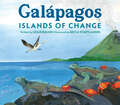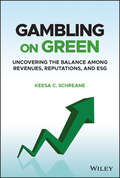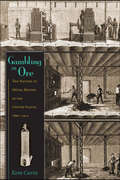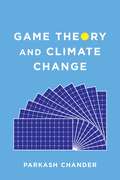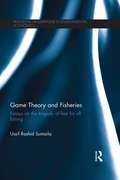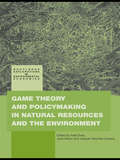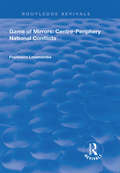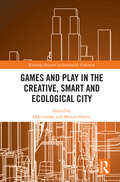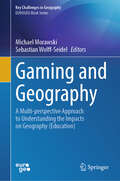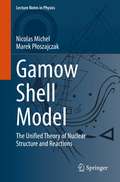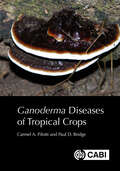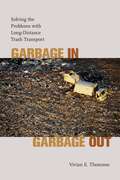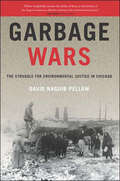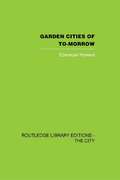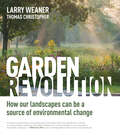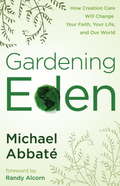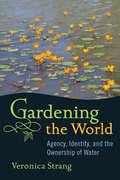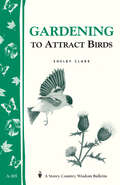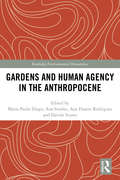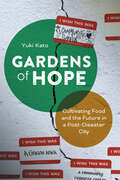- Table View
- List View
Galápagos: Islands of Change
by Leslie BulionA poetic introduction to a distinctive island ecosystem that is home to many species found nowhere else on Earth.Using the same poetry/science note format as Serengeti, Galápagos tells the complex story of a young volcanic ecosystem influenced by seasonal ocean currents, where food energy moves through integrated land and sea communities, each in its own season of growth and renewal.Millions of years ago, undersea volcanos in the eastern Pacific Ocean erupted, spewing up lava, rocks, and ash that eventually formed a cluster of islands: the archipelago known as the Galápagos Islands. Over time, castaway plants and animals from hundreds of miles away arrived on the rocky shores and adapted to each island&’s changing volcanic landscape and seasonal weather variations.In these isolated locations constantly affected by shifting winds and swift ocean currents, much of the wildlife evolved into species found nowhere else on Earth. Some of the many distinctive organisms featured include giant daisy trees, Galápagos penguins, marine iguanas, blue footed boobies, and Galápagos giant tortoises.The well-researched back matter includes poetry notes, a glossary, resources, and a list of the species from this remarkable ecosystem that are highlighted in the book.
Gambling on Green: Uncovering the Balance among Revenues, Reputations, and ESG (Environmental, Social, and Governance)
by Keesa C. SchreaneAre you an investor who wants to make the world a better place while getting stronger returns? Are you an executive building a sustainable business and seeking increased revenue? Are you curious about ESG and what it means for your community or organization? Then this book is for you! In Gambling on Green: Uncovering the Balance between Revenues, Reputations, and ESG, veteran financial services executive Keesa Schreane delivers a straightforward and practical guide for business leaders and investors navigating the world of environmental, social, and governance (ESG) issues. As ESG debates and scandals find their way to both newspapers and 10-Ks, many managers feel lost and unclear about how to drive a sustainable approach. Readers will learn to identify corporate sustainability, recognize good corporate governance and social responsibility, and understand what makes a company an exemplary steward of the environment. You&’ll also discover: Why ESG investing is increasingly important and how the most successful asset managers are building their sustainable portfolios How a business commitment to creating products with ESG in mind can benefit revenue efforts and increase customer loyalty How to cut business costs through sustainable operations Different sustainable bonds and how to leverage each to promote ESG while maintaining positive returns How some companies have incorporated ESG with spectacular success and others have ignored it completely—sometimes, to their perilWith compelling case studies and thoughtful analysis, Gambling on Green is a must-read for anyone interested in how investors and corporations are shifting their focus toward environmental, social, and governance issues. This book will earn a place on the shelves of retail and institutional investors, executives, and board members looking for a roadmap to some of the defining corporate and social issues of our time.
Gambling on Ore: The Nature of Metal Mining in the United States, 1860–1910 (Mining the American West)
by Kent CurtisGambling on Ore examines the development of the western mining industry from the tumultuous and violent Gold Rush to the elevation of large-scale copper mining in the early twentieth century, using Montana as representative of mining developments in the broader US mining west. Employing abundant new historical evidence in key primary and secondary sources, Curtis tells the story of the inescapable relationship of mining to nature in the modern world as the United States moved from a primarily agricultural society to a mining nation in the second half of the nineteenth century. In Montana, legal issues and politics—such as unexpected consequences of federal mining law and the electrification of the United States—further complicated the mining industry’s already complex relationship to geology, while government policy, legal frameworks, dominant understandings of nature, and the exigencies of profit and production drove the industry in momentous and surprising directions. Despite its many uncertainties, mining became an important part of American culture and daily life. Gambling on Ore unpacks the tangled relationships between mining and the natural world that gave material possibility to the age of electricity. Metal mining has had a profound influence on the human ecology and the social relationships of North America through the twentieth century and throughout the world after World War II. Understanding how we forged these relationships is central to understanding the environmental history of the United States after 1850.
Game Theory and Climate Change
by Parkash ChanderDespite the growing consensus on the need for action to counteract climate change, complex economic and political forces have so far prevented international actors from making much headway toward resolving the problem. Most approaches to climate change are based in economics and environmental science; in this book, Parkash Chander argues that we can make further progress on the climate change impasse by considering a third approach—game theory.Chander shows that a game-theoretic approach, which offers insight into the nature of interactions between sovereign countries behaving strategically and the kinds of outcomes such interactions produce, can illuminate how best to achieve international agreements in support of climate-change mitigation strategies. Game Theory and Climate Change develops a conceptual framework with which to analyze climate change as a strategic or dynamic game, bringing together cooperative and noncooperative game theory and providing practical analyses of international negotiations. Chander offers economic and game-theoretic interpretations of both the Kyoto Protocol and the Paris Agreement and argues that the Paris Agreement may succeed where the Kyoto Protocol failed. Finally, Chander discusses the policy recommendations his framework generates, including a global agreement to support development of cleaner technologies on a global scale.
Game Theory and Fisheries: Essays on the Tragedy of Free for All Fishing (Routledge Explorations in Environmental Economics #41)
by Ussif Rashid SumailaToday, there is a growing sense of urgency among fisheries scientists regarding the management of fish stocks, particularly among those who predict the imminent collapse of the fishing industry due to stock depletion. This book takes a game theoretic approach to discussing potential solutions to the problem of fish stock depletion. Acknowledging the classification of fish stocks as destructible renewable resources, these essays are concerned with the question of how much of the stock should be consumed today and how much should be left in place for the future. The book targets both economists and students of economics who are familiar with the tools of their trade but not necessarily familiar with game theory in the context of fisheries management. Importantly, the goal is not to give a summary evaluation of the current views of the ‘appropriate’ response to immediate policy questions, but rather to describe the ways in which the problems at hand can be productively formulated and approached using game theory and couched on real world fisheries. Game Theory and Fisheries consists of twelve previously published but updated articles in fisheries management, a number of which address a gap in the fisheries literature by modelling and analysing the exploitation of fishery resources in a two-agent fishery, in both cooperative and non-cooperative environments. The author’s work ultimately illustrates that the analysis of strategic interaction between those with access to shared fishery resources will be incomplete without the use of game theory.
Game Theory and Policy Making in Natural Resources and the Environment (Routledge Explorations in Environmental Economics)
by Ariel Dinar José Albiac Joaquín Sánchez-SorianoGame Theory has become one of the main analytical tools for addressing strategic issues in the field of economics and is increasing its influence in other fields of social sciences. With the increased level of extraction of natural resources and pollution of environments, game theory gains its place in the literature and it is more and more seen as a tool for policy makers and not only for theoreticians. The book is structured into four parts dealing with the management of natural resources, the negotiation aspects of water management, water allocation through pricing and markets, and how conflicts and regulation shape the management of the environment. The first part explores game theory concepts applied to fisheries and grazing lands, which are two important natural resources. In the next two parts, several game theory methodologies are considered in the negotiation approach to water management and approaches to water pricing and markets. The last section looks at environmental protection as the end process of the interplay between conflict and regulation. This book includes chapters by experts from developing and developed countries that apply game theory to actual issues in natural resources and the environment. As such the book is extremely useful for graduate students and technical experts interested in the sustainable management of natural resource and the environment. It is also relevant to all Game Theory and Environmental Economics students.
Game of Mirrors: Centre-periphery National Conflicts (Routledge Revivals)
by Francisco LetamendiaThis title was first published in 2000. Nationalism and the national question have represented a problem since the early years of the 19th century. Understanding these phenomena represents a challenge for political science, because "the nation" is not a natural phenomenon, rather it is the consequence of nationalism. Attempts to reduce nationalism to one or several factors have been unsuccessful; it has multiple factors that are variable in space and time. Nationalism is a problem of beliefs and conscience linked to the historical action of nationalist groups. A second difficulty derives from the distinction between nationalism of the dominant and nationalism of the oppressed. The majority of political theorists now believe that these centre and periphery nationalisms are different and therefore adversaries. Using first-hand experience of Basque separatism as a starting point, the author adds to it with the main manifestations of this phenomenon around the world.
Games and Play in the Creative, Smart and Ecological City (Routledge Research in Sustainable Urbanism)
by Dale Leorke Marcus OwensThis book explores what games and play can tell us about contemporary processes of urbanization and examines how the dynamics of gaming can help us understand the interurban competition that underpins the entrepreneurialism of the smart and creative city. Game and Play in the Creative, Smart and Ecological City is a collection of chapters written by an interdisciplinary group of scholars from game studies, media studies, play studies, architecture, landscape architecture and urban planning. It situates the historical evolution of play and games in the urban landscape and outlines the scope of the various ways games and play contribute to the city’s economy, cultural life and environmental concerns. In connecting games and play more concretely to urban discourses and design strategies, this book urges scholars to consider their growing contribution to three overarching sets of discourses that dominate urban planning and policy today: the creative and cultural economies of cities; the smart and playable city; and ecological cities. This interdisciplinary work will be of great interest to students and scholars of game studies, play studies, landscape architecture (and allied design fields), urban geography, and art history.
Gaming and Geography: A Multi-perspective Approach to Understanding the Impacts on Geography (Education) (Key Challenges in Geography)
by Michael Morawski Sebastian Wolff-SeidelThis book explores the uncharted territory where gaming and geography intersect in "Gaming and Geography (Education)." This book bridges the gap between video games and geography, delving into the constructivist creative processes of game development, gameplay, and critical reflections on video games' role in geographical discourses. Through a multi-perspective lens, the book examines how video games can facilitate the exploration of geographic questions and act as catalysts for critical discourses. Scholars shed light on the geographies presented in video games, including their representations, spatial images, and policies. By viewing video games as cultural and critical geography practices, the authors enrich the political, socio-cultural, and critical geographies associated with this medium. A key argument of the book is that video games can foster systemic competence and networked thinking, particularly in addressing complex socio-ecological challenges like climate change and migration. In contrast to traditional geography classes, digital games provide valuable simulations of complex systems, enhancing students' understanding and skills. The book also explores other possibilities such as digital field trips and language support to enhance the educational experience. "Gaming and Geography (Education)" offers a compelling narrative that highlights the diverse roles video games can play in geographic education. By exploring the intersection of gaming and geography, this book deepens our understanding of this dynamic relationship and its impact on critical geographies within the realm of video games.
Gamow Shell Model: The Unified Theory of Nuclear Structure and Reactions (Lecture Notes in Physics #983)
by Nicolas Michel Marek PłoszajczakThis book provides the first graduate-level, self-contained introduction to recent developments that lead to the formulation of the configuration-interaction approach for open quantum systems, the Gamow shell model, which provides a unitary description of quantum many-body system in different regimes of binding, and enables the unification in the description of nuclear structure and reactions. The Gamow shell model extends and generalizes the phenomenologically successful nuclear shell model to the domain of weakly-bound near-threshold states and resonances, offering a systematic tool to understand and categorize data on nuclear spectra, moments, collective excitations, particle and electromagnetic decays, clustering, elastic and inelastic scattering cross sections, and radiative capture cross sections of interest to astrophysics. The approach is of interest beyond nuclear physics and based on general properties of quasi-stationary solutions of the Schrödinger equation – so-called Gamow states. For the benefit of graduate students and newcomers to the field, the quantum-mechanical fundamentals are introduced in some detail. The text also provides a historical overview of how the field has evolved from the early days of the nuclear shell model to recent experimental developments, in both nuclear physics and related fields, supporting the unified description. The text contains many worked examples and several numerical codes are introduced to allow the reader to test different aspects of the continuum shell model discussed in the book.
Ganges: The Many Pasts of an Indian River
by Sudipta SenA sweeping, interdisciplinary history of the world’s third-largest river, a potent symbol across South Asia and the Hindu diaspora Originating in the Himalayas and flowing into the Bay of Bengal, the Ganges is India’s most important and sacred river. In this unprecedented work, historian Sudipta Sen tells the story of the Ganges, from the communities that arose on its banks to the merchants that navigated its waters, and the way it came to occupy center stage in the history and culture of the subcontinent. Sen begins his chronicle in prehistoric India, tracing the river’s first settlers, its myths of origin in the Hindu tradition, and its significance during the ascendancy of popular Buddhism. In the following centuries, Indian empires, Central Asian regimes, European merchants, the British Empire, and the Indian nation-state all shaped the identity and ecology of the river. Weaving together geography, environmental politics, and religious history, Sen offers in this lavishly illustrated volume a remarkable portrait of one of the world’s largest and most densely populated river basins.
Ganoderma Diseases of Tropical Crops
by Paul Bridge Dr Carmel A PilottiThe fungal genus Ganoderma includes around 80 currently recognized species that are widely distributed in temperate, subtropical and tropical regions, and cause disease in a range of economically important perennial crops and tree-like plants. Ganoderma root and lower stem rots have a significant impact on yields from crops including oil palm, coconut, beverage crops, Acacia and rubber. The identification of species responsible for stem and butt rots is often ambiguous as closely related species may only be distinguished by subtle morphological differences. Within species there can be considerable morphological plasticity and this can make morphology-based identification difficult, particularly for species described from a single specimen. Molecular techniques are helping to slowly resolve Ganoderma taxonomy but it will be some time (if ever) before the taxonomy is fully resolved. This book brings together information on Ganoderma species that are reported to be responsible for crop diseases in tropical and sub-tropical agriculture and covers taxonomy, biology, genetics, aetiology, epidemiology and control. This book is an essential resource for researchers in Ganoderma in crop science and tropical agriculture, as well as practitioners and industry.
Garbage In, Garbage Out: Solving the Problems with Long-distance Trash Transport
by Vivian E. ThomsonYour garbage is going places you'd never imagine. What used to be sent to the local dump now may move hundreds of miles by truck and barge to its final resting place. Virtually all forms of pollution migrate, subjected to natural forces such as wind and water currents. The movement of garbage, however, is under human control. Its patterns of migration reveal much about power sharing among state, local, and national institutions, about the Constitution's protection of trash transport as a commercial activity, and about competing notions of social fairness. In Garbage In, Garbage Out, Vivian Thomson looks at Virginia's status as the second-largest importer of trash in the United States and uses it as a touchstone for exploring the many controversies around trash generation and disposal.Political conflicts over waste management have been felt at all levels of government. Local governments who want to manage their own trash have fought other local governments hosting huge landfills that depend on trash generated hundreds of miles away. State governments have tried to avoid becoming the dumping grounds for cities hundreds of miles away. The constitutional questions raised in these battles have kept interstate trash transport on Congress's agenda since the early 1990s. Whether the resulting legislative proposals actually address our most critical garbage-related problems, however, remains in question.Thomson sheds much-needed light on these problems. Within the context of increased interstate trash transport and the trend toward privatization of waste management, she examines the garbage issue from a number of perspectives--including the links between environmental justice and trash management, a critical evaluation of the theoretical and empirical relationship between economic growth and environmental improvement, and highlighting the ways in which waste management practices in the US differ from those in the European Union and Japan. Thomson then provides specific, substantive recommendations for our own policymakers.Everything eventually becomes trash. As we explore the long, often surprising, routes our garbage takes, we begin to understand that it is something more than a mere nuisance that regularly "disappears" from our curbside. Rather, trash generation and management reflect patterns of consumption, political choices over whether garbage is primarily pollution or commerce, the social distribution of environmental risk, and how our daily lives compare with those of our counterparts in other industrialized nations.
Garbage Wars: The Struggle for Environmental Justice in Chicago (Urban and Industrial Environments)
by David Naguib PellowA study of the struggle for environmental justice, focusing on conflicts over solid waste and pollution in Chicago.In Garbage Wars, the sociologist David Pellow describes the politics of garbage in Chicago. He shows how garbage affects residents in vulnerable communities and poses health risks to those who dispose of it. He follows the trash, the pollution, the hazards, and the people who encountered them in the period 1880-2000. What unfolds is a tug of war among social movements, government, and industry over how we manage our waste, who benefits, and who pays the costs.Studies demonstrate that minority and low-income communities bear a disproportionate burden of environmental hazards. Pellow analyzes how and why environmental inequalities are created. He also explains how class and racial politics have influenced the waste industry throughout the history of Chicago and the United States. After examining the roles of social movements and workers in defining, resisting, and shaping garbage disposal in the United States, he concludes that some environmental groups and people of color have actually contributed to environmental inequality.By highlighting conflicts over waste dumping, incineration, landfills, and recycling, Pellow provides a historical view of the garbage industry throughout the life cycle of waste. Although his focus is on Chicago, he places the trends and conflicts in a broader context, describing how communities throughout the United States have resisted the waste industry's efforts to locate hazardous facilities in their backyards. The book closes with suggestions for how communities can work more effectively for environmental justice and safe, sustainable waste management.
Garden Cities
by Sarah RutherfordGarden Cities: the phrase is redolent of Arts and Crafts values and nineteenth-century utopianism. But despite being the culmination of a range of influential movements, and having global influence themselves, in fact there were only ever two true, self-contained Garden Cities in England - far more numerous were Garden Suburbs and Villages. Crystallised in England by social visionary Ebenezer Howard and executed in many cases by planners and architects Barry Parker and Raymond Unwin, the concept arose from nineteenth-century industrial settlements like Port Sunlight (and, earlier, Saltaire and Akroyden), and also from the City Beautiful movement in the US. The settlements were designed to promote healthy and comfortable individual and community life, as well as supporting commerce and industry, and were - and are - instantly and attractively recognisable. This book is a beautifully illustrated guide to the movement as a whole, from its earliest influences through practical difficulties in implementation to the continuing vitality of the communities which are its legacy.
Garden Cities of To-Morrow
by Ebenezer HowardOriginally published in 1898 as To-Morrow: A peaceful path to reform, "the book", writes F.J. Osborn "holds a unique place in town planning literature, is cited in all planning bibliographies, stands on the shelves of the more important libraries, and is alluded to in most books on planning; yet most of the popular writers on planning do not seem to have read it - or if they have read it, to remember what it says." The book led directly to two experiments in town-founding that by imitation, and imitation of imitation, have had a profound influence on practical urban development throughout the world. The book was responsible for the introduction of the term Garden City in numbers of languages - Cite-Jardin, Gartenstadt, Ciudad-jardin, Tuinstad - and set into motion ideas that have helped transform the scientific and political outlook on town structure and town growth. With urban renewal and the development of suburban communities as features of the contemoprary American scene, Garden cities of To-Morrow becomes "must" reading. In the words of Lewis Mumford: "This is not merely a book for Technicians: above all it is a book for citizens, for the people whose actively expressed needs, desires and interests should guide the planner and administrator at every turn." This book was first published in it's current form in 1965.
Garden Revolution: How Our Landscapes Can Be a Source of Environmental Change
by Thomas Christopher Larry WeanerAHS Book Award winner This lushly-photographed reference is an important moment in horticulture that will be embraced by anyone looking for a better, smarter way to garden. Larry Weaner is an icon in the world of ecological landscape design, and now his revolutionary approach is available to all gardeners. Garden Revolution shows how an ecological approach to planting can lead to beautiful gardens that buck much of conventional gardening’s counter-productive, time-consuming practices. Instead of picking the wrong plant and then constantly tilling, weeding, irrigating, and fertilizing, Weaner advocates for choosing plants that are adapted to the soil and climate of a specific site and letting them naturally evolve over time. Allowing the plants to find their own niches, to spread their seed around until they find the microclimate and spot that suits them best, creates a landscape that is vibrant, dynamic, and gorgeous year after year.
Gardening Eden: How Creation Care Will Change Your Faith, Your Life, and Our World
by Michael AbbateBefore the snake,the apple,and the Ten Commandments,God created a garden..."Spiritual environmentalism" did not start out as an oxymoron-it was an invitation. Yet today, many believe God's first job description for humankind has been replaced by other "worthier pursuits". Why has this simple instruction become so controversial? How does one sort through all the mixed messages? Is changing our lives to save the world really our responsibility-or even possible?Gardening Eden invites you to consider a new, spiritual perspective to practical environmentalism. The question is not whether our souls find expression and inspiration in our incredible planet, but how best to preserve that fundamental connection. Green living is no longer a fad-simple lifestyle solutions are now available to everyone. Discover creation care as an act of worship and a call to deeper harmony with our Creator, our fellow gardeners, and our living Earth. Gardening Eden is the primer in how this shift will transform not only our world, but your very soul.From the Trade Paperback edition.
Gardening The World
by Veronica StrangAround the world, intensifying development and human demands for fresh water are placing unsustainable pressures on finite resources. Countries are waging war over transboundary rivers, and rural and urban communities are increasingly divided as irrigation demands compete with domestic desires. Marginal groups are losing access to water as powerful elites protect their own interests, and entire ecosystems are being severely degraded. These problems are particularly evident in Australia, with its industrialised economy and arid climate. Yet there have been relatively few attempts to examine the social and cultural complexities that underlie people's engagements with water. Based on long-term ethnographic fieldwork in two major Australian river catchments (the Mitchell River in Cape York, and the Brisbane River in southeast Queensland), this book examines their major water using and managing groups: indigenous communities, farmers, industries, recreational and domestic water users, and environmental organisations. It explores the issues that shape their different beliefs, values and practices in relation to water, and considers the specifically cultural or sub-cultural meanings that they encode in their material surroundings. Through an analysis of each group's diverse efforts to 'garden the world', it provides insights into the complexities of human-environmental relationships.
Gardening Under Lights: The Complete Guide for Indoor Growers
by Leslie F. Halleck“If you want to grow plants indoors, you need this book.” —Niki Jabbour, author and staff writer at savvygardening.comGardening Under Lights is a highly-detailed, accessible guide for seed starters, plant collectors, houseplant fans, and anyone who wants to successfully garden indoors any time of the year. You’ll learn the basics of photosynthesis, the science of light, how to accurately measure how much light a plant needs, and details about the most up-to-date tools and gear available. Also included are tips and techniques for helping ornamental plants (like orchids, succulents, bonsai, and more) and edible plants (arugula, cannabis, oregano, tomatoes, and more) thrive indoors. Whether you are a vegetable gardener who wants to extend the growing season, a balcony gardener short on outdoor space, or a specialty plant collector, Gardening Under Lights is a must-have.
Gardening to Attract Birds: Storey's Country Wisdom Bulletin A-205 (Storey Country Wisdom Bulletin Ser.)
by Shelby ClarkSince 1973, Storey's Country Wisdom Bulletins have offered practical, hands-on instructions designed to help readers master dozens of country living skills quickly and easily. There are now more than 170 titles in this series, and their remarkable popularity reflects the common desire of country and city dwellers alike to cultivate personal independence in everyday life.
Gardens and Human Agency in the Anthropocene (Routledge Environmental Humanities)
by Ana Simões Maria Paula Diogo Ana Duarte Rodrigues Davide ScarsoThis volume discusses gardens as designed landscapes of mediation between nature and culture, embodying different levels of human control over wilderness, defining specific rules for this confrontation and staging different forms of human dominance. The contributing authors focus on ways of rethinking the garden and its role in contemporary society, using it as a crossover platform between nature, science and technology. Drawing upon their diverse fields of research, including History of Science and Technology, Environmental Studies, Gardens and Landscape Studies, Urban Studies, and Visual and Artistic Studies, the authors unveil various entanglements woven in the past between nature and culture, and probe the potential of alternative epistemologies to escape the predicament of fatalistic dystopias that often revolve around the Anthropocene debate. This book will be of great interest to those studying environmental and landscape history, the history of science and technology, historical geography, and the environmental humanities.
Gardens of Hope: Cultivating Food and the Future in a Post-Disaster City
by Dr. Yuki KatoSocial changes through urban gardening and farmingGardens are often spaces of hope, expected to solve many problems in a city including food insecurity and climate resilience. In fact, there has been a historical trend of urban gardening gaining popularity during times of crisis. Gardens of Hope is the story of urban gardening in New Orleans in the decade after Hurricane Katrina. Yuki Kato highlights the impact urban gardens have on communities after disasters and the efforts of well-intended individuals envisioning alternative futures in the form of urban farming.Drawing on repeated interviews with residents who began cultivation projects in New Orleans between 2005 and 2015, Kato explains how good intentions and grit were not enough to implement or sustain urban gardeners’ visions for the post-disaster city’s future. Coining the term “prefigurative urbanism,” Kato illustrates how individuals tried to realize alternative ways of living and working in the city through pragmatism and innovation. Gardens of Hope asks key questions about what inspires and enables individuals to pursue prefigurative urbanism and about the potential and limitations of this form of civic engagement to bring about short- and long-term changes in cities undergoing transformation, from gentrification, post-pandemic recovery, to climate change.
Gas Dynamics with Applications in Industry and Life Sciences: On Gas Kinetic/Dynamics and Life Science Seminar, March 25–26, 2021 and March 17–18, 2022 (Springer Proceedings in Mathematics & Statistics #429)
by Larisa Beilina Mohammad Asadzadeh Shigeru TakataThis proceedings volume gathers selected contributions presented at two instances of the "JSPS/SAC Seminar: On Gas Kinetic/Dynamics and Life Science", held by the Chalmers University of Technology and University of Gothenburg, Sweden, on March 25-26, 2021 (virtual) and March 17-18, 2022 (virtual).Works in this book provide a concise approach to the theoretical and numerical analysis of kinetic type equations that arise, for example, in modeling industrial, medical, and environmental problems. Readers will find some of the most recent theoretical results, newly developed numerical methods in the field, and some open problems. Possible application areas encompass fission/fusion energy, electromagnetics, nuclear science and engineering, medical service, radiation oncology, and plants growth conditions, to name a few. The JSPS/SAC seminars are jointly organized by JSPS (Japan Society for the Promotion of Science)—Stockholm Office and the Department of Mathematical Sciences, Chalmers University of Technology & University of Gothenburg, Sweden. These seminars foster discussions on the mathematical theory, industrial and life science applications, and numerical analysis of non-linear hyperbolic partial differential equations modeling collision-less plasma and charged particles.Chapter 4 is available open access under a Creative Commons Attribution 4.0 International License via link.springer.com.Chapter 11 is available open access under a Creative Commons Attribution 4.0 International License via link.springer.com.
Gas Explosion and Its Protection Technology in Process Industries
by Zhirong Wang Xingyan CaoThis open access book first introduces the explosive characteristics of combustible gas in the process industrial device, and then introduces the influence law of structural effect on gas explosion characteristics and deflagration to detonation process, and finally introduces the suppression mechanism and protection technology of gas explosion. This book takes the process industrial gas explosion characteristics and its protection as the research object, and discusses the gas explosion characteristics and its protection theory in details. This book can be used as the undergraduate and graduate textbook of safety engineering and related engineering majors in universities, and also as a reference for scientific research staff in safety science and engineering and related disciplines, and also for the reference of safety technology and management personnels.
